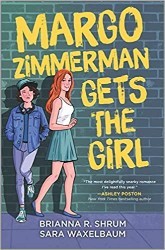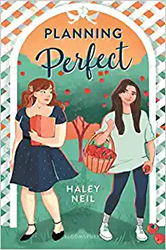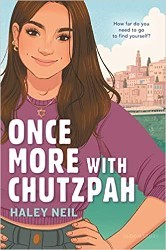
Author photo of Sara Waxelbaum and Brianna R. Shrum by Cody Pennell
Author photo of Haley Neil by Sophie Macdonald
Haley Neil and coauthors Brianna R. Shrum and Sara Waxelbaum discuss their recent books, Planning Perfect and Margo Zimmerman Gets the Girl respectively. They explore Jewish and queer representation in literature, crafting captivating characters, and the legacy of genocide over generations.
Brianna R. Shrum/Sara Waxelbaum: First off, we are so glad to get the chance to talk with you about Felicity’s story. Are we now old enough that we couldn’t stop talking about how much we related to the mom in the story? Yes. DOES THAT EVEN MATTER? …also yes. Planning Perfect is a beautiful exploration of character, family, and what it means to love with acceptance. As Jewish readers and writers, we were also, of course, so glad to be able to sink into a Jewish story like this one. How did your own Jewish experience influence the development of the Becker family and dynamics?
Haley Neil: My first book, Once More with Chutzpah, actually drew pretty heavily on my own Jewish experience. I grew up in an interfaith household, so I long felt like I was Jew-ish. Like I wasn’t enough. Like I had to fight to prove that I belonged. As I got older and started to connect more and more to the Jewish side of my family and culture, those doubts and worries stuck with me. So, for my debut, I wrote about a main character who is figuring out her place when it comes to her own background. She eventually realizes that she is more than enough.
I wanted to do something different with Planning Perfect. In this book, Felicity is Jewish. It’s a fact. There is no doubt about it. If my first book is the question “who am I?” then Planning Perfect is the follow-up: “Cool, but what does that mean in practice?”
BS/SW: I loved the Beckers’ Shabbat traditions, and how their non-religious practices were treated with the same importance as religious practices. Without denigrating the religious elements many participate in on Shabbat, you really managed to capture the Beckers setting it apart in their own, beautiful way. How did you approach forming these traditions and working in the nuance of those elements?
HN: Am I about to reference the Netflix show Jewish Matchmaking? It certainly appears so! In the show, the matchmaker, Aleeza Ben Shalom, makes a comment about how there are fifteen million Jews in the world…and about fifteen million ways to be Jewish! I’ve seen it with my own family, I’ve seen it with friends. There are so many beautiful, wonderful, unique ways to connect to Jewish traditions. During the pandemic, my mom and I started doing Shabbat dinner together. We lit the candles, took out my childhood tzedakah box, debated over where to find the best challah, played the prayers on Youtube: just the two of us. I wanted to take some of that into the story.
I’ve been calling this book Gilmore Girls but make it Jewish. I really wanted to show the mother-daughter-grandmother dynamic. They each connect to their Jewishness in different ways. I wanted to show that concretely through their traditions. Those connections are different, sure, but all of them are valid!
BS/SW: Over the course of the book, Felicity learns how to let go and let people be their own authentic selves, instead of what she thinks they should be – including herself! How did you find the balance between the concrete representation of the character’s growth (Felicity planning her mother’s wedding) and the quieter arc of the evolution of her relationship with Nancy?
HN: I think this one might come down to a bit of a technicality! I had a deadline for the plot about the wedding. I knew I wanted it to take place over the summer, so I was able to set firm dates from there. But, with the relationship arc… I actually changed the entire timeline for that one during revisions! I found that I was writing to typical romance beats, instead of considering what might look different for a character on the asexual spectrum. To me, it was really important to tell an authentic story. Felicity and Nancy fall in love over time. They have this foundation of friendship. And the whole time, Felicity feels that romantic connection, but worries that, because she’s ace-spectrum, Nancy won’t be interested in her that way.
I’m a firm believer in bridging humor and heart, high emotions and quieter feelings, to tell a full and complete story. All of those moments – the wedding planning, the relationship – ultimately come together to help Felicity learn and grow.
BS/SW: The strained mother-daughter relationships in your book add a real layer of complexity to the story – and, I’m sure, relatability to so many readers. Can you expand a little on the role of intergenerational expectations, especially within Jewish culture?
HN: I was talking about this with my family over Passover! It is fascinating to look from a generational perspective and see the way that trauma influences expectations. The ways in which we learn how to behave, how to stay safe, and how that is then passed on and changed based on new environments. Some of this comes back to pogroms, diaspora, the Holocaust. That trauma stays in families, sometimes in ways you wouldn’t expect.
When it comes to the mother-daughter-bubbe connection in the book, we have three very different women. Bubbe is more traditional in her Jewishness. She is concerned about doing the right things in the right ways. There is a lot of pressure there. Because of this, Felicity’s mom is untraditional to a fault. And then there is Felicity, almost caught in the middle. There’s a scene later in the book that I referred to as the generational trauma scene. Bubbe tries to open up to Felicity. She’s not entirely able to explain herself. What she does say is that her expectations are solidly rooted in a place of protection. She wants her family to be safe. Does she do it in the best way… not at all. But for me, that was important to show because it felt very real.
Just like how there is no one way to be Jewish, there is no single way to be queer.
BS/SW: There are few things that are more important in literature than true intersectional portrayals, as no one is just one thing. We’d love to get your ideas on the importance of representation in queer romance literature and how your book contributes to providing diverse and authentic portrayals of Jewish queer characters.
HN: No person is one single thing! Identities and backgrounds are always so complex. Just like how there is no one way to be Jewish, there is no single way to be queer (something you both show so beautifully in Margo Zimmerman Gets the Girl!). I am deeply honored that I get to write queer Jewish representation. I am overwhelmed in the best way to see lists — plural! — of queer Jewish books. I hope my writing can be an example, one among many, that maybe in some small way helps a reader feel seen.
BS/SW: What is the one thing you want readers to walk away with when they finish your book?
HN: There is no such thing as a perfect plan for your future. Sometimes the best parts of life are entirely unexpected.
HN: And now it is time to turn the tables! I am so thrilled to talk to you both about Margo Zimmerman Gets the Girl! I embarrassed myself in public when I decided to read this on a train (and ended up laughing so many times I concerned the person sitting next me). So now I have to embarrass you two by showering you both with praise. What a book! From humor to hug-the-book emotional scenes, you had me hooked.
I have to start off by asking a very themed question. For readers who haven’t picked up this delightful book yet, the story centers on a girl who has recently realized that she’s gay and turns to one of her peers for Queer 101 lessons. If you were running Queer 101, what would be the first lesson?
SW: I think Margo Zimmerman is the first lesson of Queer 101: there’s no right way – or wrong way – to be gay.
BS: And alongside that, Abbie takes lesson one to define a million terms that almost seem insulting (and knowing Abbie, that’s not one hundred percent untrue), but I’d want to get across that queerness means more than one thing; there are a million ways to be queer.
HN: What books would be on your Queer 101 syllabus? Would they be the same as the ones Abbie put on her syllabus?
SW: Stephen Fry’s autobiography Moab Is My Washpot–he’s queer and Jewish, so bonus points there. Oscar Wilde’s The Picture of Dorian Gray, which is about as queer as a book could have been when being queer was a capital offense. (My 11th grade English lit teacher assigned it – can you imagine – and that was the second time I read it. I’m very cool.) My controversial recommendation is going to be James Joyce’s Portrait of the Artist as a Young Man. I was sixteen when I read it, and it deeply affected me. If learning “bisexual” was a word was the gasp, Portrait was the relieved exhale. And, well, it’s not a book, but Our Flag Means Death. It has some of the best and widely varied queer representation I’ve seen in fiction media, I mean. Ever.
BS: WELL SUSSED. Truly, we’ve watched that so many times that we’ve lost count, and a huge reason is its joyful queerness, and its queer joy. In the non-fiction realm, so many of the titles we would put on a syllabus for this class are the ones we…well…had Abbie put on her own syllabus. Outside of those, my Queer 101 class would be as unhinged as the SAT prep class I once taught (wherein I taught about semi-colons by making kids correct sentences about bisexual icon Julie D’Aubigny and polyamorous queer pirates Anne Bonny, Jack Rackham, and Mary Read). Because if I’m talking queer lit? I’m talking about Mira Grant’s Into the Drowning Deep and Tessa Gratton’s Strange Grace and Lev Rosen’s Jack of Hearts (And Other Parts). And probably getting the administration called on me for it, but hey, what else is new?
HN: One of the things I noticed in both of our books was the matter-of-fact way in which Jewishness is treated. The characters are Jewish. It’s a fact; just another part of the story. Did you both always know that you wanted to write matter-of-fact Jewish characters in this book?
SW: I did. I basically write all my characters Jewish unless there’s a reason they shouldn’t be. I grew up in the 90s and the Jewish characters that were available in the library were all tragic. (I latched on to Letters from Rivka because at least this sad historical wasn’t about the Holocaust.) It’s important to me to see living, breathing, happy, thriving, normal Jewish people being Jewish today, because I didn’t get to see that as a kid. I grew up in Florida and South Carolina, so not only did I not get to see it in books, I barely got to see it outside of synagogue.
One of the damnedest things about genocide is how it reverberates through generations. Communities who weren’t subjected often aren’t aware of survivors. (Honestly, it’s a huge issue for Indigenous people.) People get fixated on the tragedy, the sensationalism of it, and suddenly your identity and culture and heritage and everything has been reduced to Number the Stars. And, not for nothing, when existence is resistance, publishing two big middle fingers is pretty satisfying.
BS: This was also important to me, as I didn’t grow up Jewish; I converted as an adult. Jewishness was something I chose to belong to, and chose to belong to me. And frequently, because I grew up evangelical, that choice is met with…resistance. During that process, I would bring little copies of things likes “biographies of Hillel” to places I knew they might not be well-received, and now, I bring Jewish characters along with me into my stories. Because Jewish people are, and Jewish characters are, and writing Jews existing and loving and facing challenge and struggle and love and life is a way of embracing my own identity, and doing it with gusto.
HN: What was the co-writing process like?
SW: Either completely silent or neither of us can shut up.
BS: It’s a lot easier to co-write, it turns out, when you share a brain.
SW: My husband spends a lot of time experiencing the world in stereo.
BS: And if her mom is around, suddenly the room is set up in Dolby surround sound.
SW: All the books we’ve cowritten have been dual points of view. Everything is in a shared Google doc so we both have access to the most up-to-date version of the story and outline. We each create the character we’re going to write, but we do it jointly so the motivations and all that match up. The chapters and scenes that are only one character we do on our own time, but anything where they interact we sit down and write their dialogue back and forth in real time.
BS: That’s basically it! Honestly, I always thought co-writing would be impossibly difficult – until Sara and I tried it. We joke about sharing a brain, but we truly do both think similarly and more importantly, respect each other’s writing deeply, which makes writing together stunningly smooth. We’ve only ever disagreed the one time. When we got into a HUGE, MASSIVE FIGHT–
SW: It was not a huge, massive fight. It was Bri being unreasonable. Un-bri-sonable.
BS: It was technically me having forgotten to eat or drink any water at all for like nine hours and then thinking that having a half a glass of wine was a good idea, which led to me thinking, for about twenty minutes, that having our main character commit felony arson was a really good idea, also.
SW: The character did not commit felony arson.
HN: Do either of you have any silly or untraditional writing habits? (I’m not saying I bought a few swing style dresses so I could look like Felicity while I wrote but…)
BS: First off – please link me to those dresses? Sometimes my gender is “can wear dresses today,” and on those days, it’s important to be stocked up on swing dresses. Secondly, honestly, I don’t think I have anything too off-kilter here! The oddest thing I’ll do is rather than listening to music, I often listen to sound effects that my characters are experiencing. If they’re in a coffee shop, it’s coffee shop sounds. At a campfire, I’ll find ambient campfire noise. I want to be where they are, and that’s the closest way I can think of to do it, until teleportation becomes mainstream.
SW: I’m pretty boring: I mainline caffeine and listen to music. Once I drafted an entire eighty-thousand word book to only the original Hunger Games soundtrack. The book was garbage but that soundtrack still slaps.
HN: What is your main Queer 101 learning objective? I realize this is the same as asking about the main takeaway from your book, but I’m sticking to the theme!
BS: I guess a lot of this goes back to our first answer, and that is – babe, if you’re queer, you’re queer. Not only do you get to define your own queerness, but queerness as a whole is being defined by you. By your presence in it. How cool and powerful is that?
SW: No matter what anyone tells you, from any position of power, real or imagined: SAY GAY.
Haley Neil is the author of Once More With Chutzpah and Planning Perfect, and a recent MFA grad from The New School, where she specialized in Writing for Children and Young Adults. She previously obtained her Masters in Education while working full time as a preschool teacher. She loves school, teaching, and going to school to learn about teaching (as well as walking her rescue pup through her Massachusetts town and working at her local library).
Brianna R. Shrum is the author of six novels for young adults, including Never, Never; How to Make Out; The Art of French Kissing; Kissing Ezra Holtz — And Other Things I Did For Science; The Liar’s Guide to the Night Sky; and Rebel Boys and Rescue Dogs – or – Things That Kiss With Teeth. Her work has been translated into multiple languages across two continents. She is queer and Jewish and rebelliously lives in the Bible Belt (South Carolina) with her favorite people, when she’s not writing, you can usually find her climbing rocks or reading with a chai.
Sara Waxelbaum is the author of contemporary YA novels. Under the name Sara Taylor Woods, she is the author of erotic romance, including Hold Me Down, a HOLT Medallion finalist in two categories.


